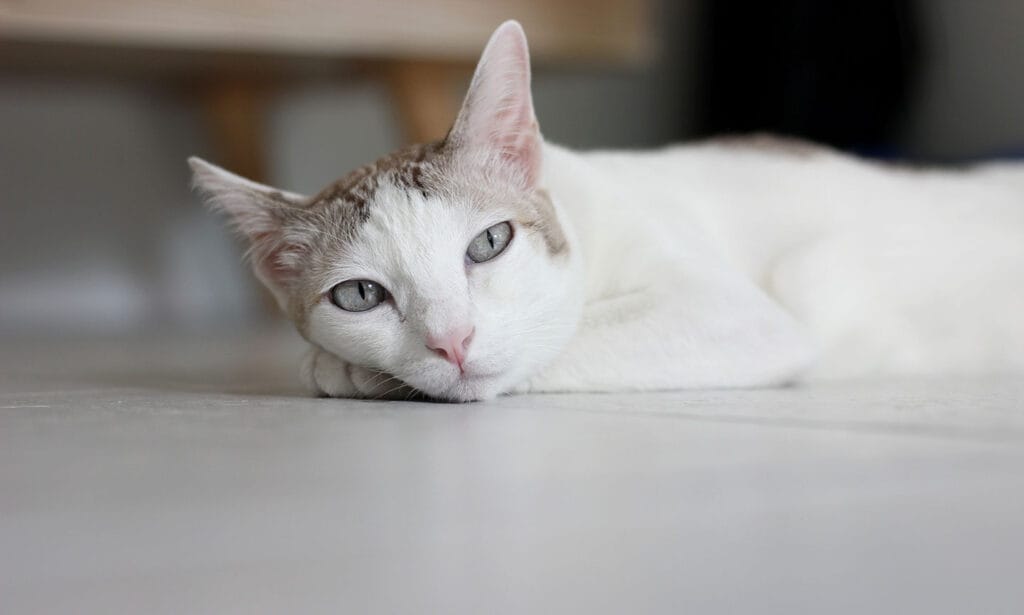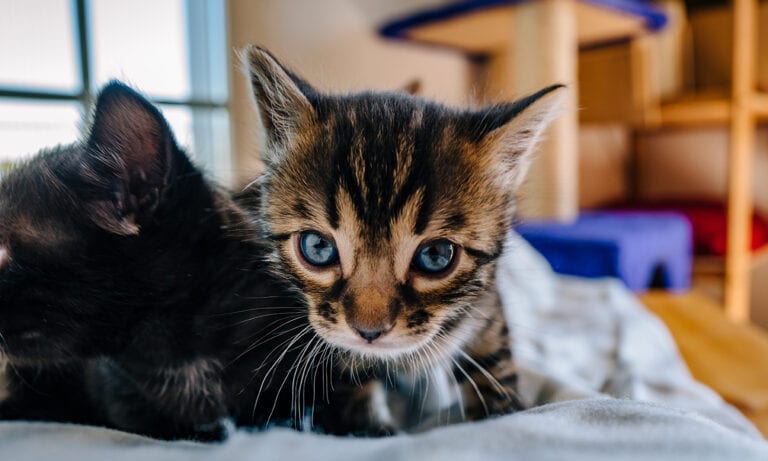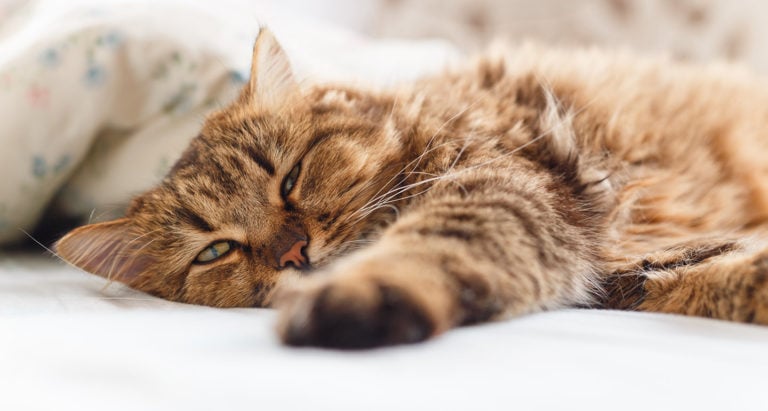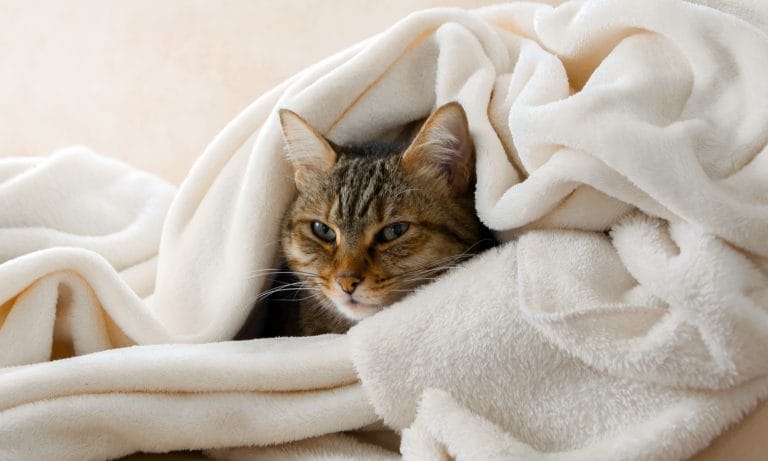In general, cats are clean and tidy roommates. One notable exception? You guessed it, cat parents: vomiting.
So, why is your cat throwing up? Vomiting can be caused by a variety of factors, including hairballs, food sensitivities, infections, and other diseases.
Cat vomiting falls into two categories: chronic vomiting—meaning it happens with some degree of regularity—and acute vomiting— meaning it happens suddenly and repeatedly.
While relatively common, healthy cats don’t vomit, so you need to understand what’s behind your cat’s symptoms and seek appropriate care.
In This Guide:
Causes of Cat Throwing Up
The first step to helping your cat is understanding why they are vomiting.
Vomiting is common in cats, caused by conditions that are sudden or short term (acute) or long term (chronic), says Christen Fout, DVM, a veterinarian at Veterinary Emergency Group in Dublin, Ohio. “While no vomiting is considered normal, some cats are more prone to occasional episodes of vomiting than others.”
Causes of a cat throwing up include:
● Eating too quickly
● Upset stomach from eating food or treats that are too rich
● Ingesting foreign material (such as string, toy parts, etc.)
● Ingestion or exposure to toxins/poisons, like certain toxic foods for pets
● Internal diseases (kidney disease, liver, and gallbladder disease)
● Digestive disorders (pancreatitis, inflammatory bowel disease [IBD], ulcers in the digestive tract)
● Overactive thyroid gland (hyperthyroidism)
● Food sensitivities/allergies
● Side effect of certain medications
● Infection from internal parasites or from viral, bacterial, or fungal disease
● Cancer
Cat Vomit Color Chart
Yellow vomit
Bile causes bright yellow or greenish-yellow vomit; it can be from an empty stomach, or an underlying digestive or internal issue.
Clear/white vomit
Can be from the water contents of your cat’s stomach, from an empty stomach, and from stomach irritation; it may have a foamy appearance.
Bloody vomit
Indicates bleeding from the mouth, esophagus, or stomach; can range from light pink to dark brown, and may be slimy or even gel-like. It always warrants a prompt vet visit.
Brown vomit
Can be from the color of your cat’s undigested food, from food mixed with bile, from bleeding in the upper digestive tract, or from obstruction of the digestive tract.
“Coffee ground” or black vomit
Can be from blood in the digestive tract that has already been digested; this warrants a prompt vet visit, as it can be seen with inflammation, a bleeding ulcer, or an obstruction.
Vomit with undigested food
This means that the food never left the cat’s stomach and has been regurgitated (which is different from vomiting); it may indicate an obstruction.
When To Take a Cat to the Vet for Throwing Up
Vomiting is not always cause for concern.
“Just like with people, pets can get sick from time to time,” says Paige Adams, DVM, a veterinarian at Etowah Veterinary Hospital in Marietta, Georgia.
However, it can be a symptom of a medical emergency and can cause dangerous dehydration.
“My rule of thumb is that one episode of vomiting is OK to monitor,” says Dr. Adams. “But if it happens again, if the cat is acting sick, or if they cannot keep liquids down, that requires a vet visit.”
She recommends a trip to your vet if you notice any of the following:
● Vomiting becomes consistent or frequent
● Dehydration and lack of drinking
● Lack of appetite
● Pain
● Fresh blood, dark brown or black vomit, yellow/green bile-colored vomit
● Low energy and hiding behavior
● Diarrhea or constipation
● A worm in the vomit
Depending on your cat’s symptoms and medical history, your veterinarian may order stool testing, blood work, X-rays (radiograph), an ultrasound, endoscopy, or exploratory surgery/biopsy.
Vomiting isn’t necessarily an emergency. However, if symptoms persist, it’s time to see your vet.
My rule of thumb is that one episode of vomiting is OK to monitor. But if it happens again, if the cat is acting sick, or if they cannot keep liquids down, that requires a vet visit.
Treatment for Cat Throwing Up
Treatment for vomiting depends on your cat’s diagnosis, and ranges from medical treatment to surgery. “Your veterinarian will help determine your pet's best course of action based on their exam findings and testing results,” says Dr. Fout.
Common treatments include:
Fluids
Repeated vomiting results in your cat losing the important fluids they need to stay well hydrated.
If your cat has continued to vomit repeatedly, cannot hold down water, has stopped drinking or eating, they may be dehydrated, and your vet may give your cat fluids.
Fluids may be given either through subcutaneous fluid therapy (SQ), which means sterile fluid is injected under the skin, or an intravenous (IV) fluid therapy, which means sterile fluid is injected directly into your cat’s vein through a catheter.
IV fluid therapy offers more intense treatment and is used for cats who are acutely sick or dangerously dehydrated.
Anti-Vomiting Medication
Antiemetic (anti-vomiting) drugs help ease nausea and vomiting.
“Antiemetic medication is frequently given, Cerenia® being the most common drug we use,” says Dr. Adams.
Cerenia® is an injectable medication used for acute vomiting in cats and dogs; while it doesn’t treat the underlying cause of vomiting, it can offer your pet some relief as they recover and can help prevent further dehydration.
Your vet may also prescribe other injections and oral medications to relieve excessive buildup of stomach acid to help your cat feel better.
Diet
Your vet may prescribe a specific type of diet to help relieve your cat’s vomiting. Depending on the underlying cause of your cat’s vomiting, they may consider the following veterinary diets, available with an authorization from your vet:
For an upset stomach:
Additionally, your vet may recommend a yummy probiotic supplement powder on top of your cat’s food (like Purina Pro Plan FortiFlora® or Nutramax® Proviable®-DC probiotics) to help support your cat’s digestive system.
Probiotics help provide healthy bacteria to your cat’s digestive tract, and many cats enjoy eating their food with a tasty probiotic supplement “topper.” This serves as a double benefit to encourage your sick kitty to start eating again.
Is it OK to feed your cat a homemade diet you prepare yourself?
Generally, no—not without an expert’s help to ensure it is nutritionally complete and balanced for your cat.
So talk to your vet first, especially since a vomiting cat may have imbalances of electrolytes (sodium, potassium, chloride).
Using only a recipe formulated by an animal nutrition specialist, including vitamin and mineral supplements, is the safest way to feed your cat a homemade diet.
Antibiotics
If your cat’s vomiting is caused by a bacterial infection, your veterinarian may prescribe antibiotics. The type of antibiotic depends on the type of infection.
As some oral antibiotics can cause digestive upset (loss of appetite, nausea, vomiting, and diarrhea) your vet may decide to administer an antibiotic injection like ConveniaⓇ, which lasts for two weeks.
Surgery
In some cases, vomiting may be a symptom of serious conditions that require surgery, like bowel obstruction or cancer. In these cases, your veterinarian will discuss the different treatment plans available, as well as the recovery process.
What To Do for a Kitten Vomiting
While a wait-and-see approach can be appropriate for some adult cats, a vomiting kitten should be considered a medical emergency.
“Vomiting in kittens is more concerning,” says Grant Little, DVM, a veterinarian at Arlington Pet Hospital in Arlington, Nebraska.
“They get dehydrated faster, can get intense viral infections that cause severe vomiting, and are more likely to swallow objects by accident and get a blockage,” he explains. “If a kitten is vomiting, that is abnormal and should be seen right away.”
How To Prevent a Cat From Throwing Up
Depending on the cause of the vomiting, there are some steps pet parents can take at home to prevent future episodes, says Dr. Fout.
- Grooming: Dr. Fout recommends keeping cats well-groomed to reduce the incidence of hairballs. Brush your cat daily to remove loose hairs and prevent matting—as a bonus, it can be a great bonding activity!
- Foreign object vigilance: To avoid an intestinal obstruction, inspect your cat’s toys—anything that could be swallowed should be discarded. Do not allow your cat to play with yarn, string, rubber bands, or holiday tinsel—they can become lodged in the intestines and cause a blockage.
- Diet: Avoid switching cat foods or offering human foods, especially if your cat has a sensitive stomach. “The digestive tract of cats operates best on one type of food,” says Dr. Fout. “Keeping your cat’s diet consistent can help decrease bouts of vomiting.” Consider using a slow feeder if your cat vomits after eating too quickly.
- Routine veterinary care: Regular wellness visits can help discover health issues before they become a problem. Dr. Fout recommends annual vet visits with routine screening blood work to identify some more chronic causes of vomiting before they become a significant problem.
- Parasite prevention: Routine, year-round parasite prevention is important for both indoor and outdoor cats. Talk to your vet about all-in-one parasite prevention to protect your cat from external parasites (fleas, ticks, mites) and internal parasites (roundworms, hookworms, heartworms, tapeworms).
Cat Vomiting FAQs
Q:Why does my cat vomit after eating?
A:Cats who eat too quickly may vomit after meals; in these cases, a slow feeder (food bowl with obstacles in it, like this one from Frisco by Chewy) or food puzzle can help your cat eat more slowly.
Vomiting after eating can also indicate food allergies or sensitivities, inflammatory bowel disease, pancreatitis, hyperthyroidism, and more.
Vomiting after eating is not normal, so consult your veterinarian.
Q:When should I be concerned about my cat throwing up?
A:Vomiting is not always an emergency, but it can indicate a serious health issue.
If your cat vomits repeatedly, appears lethargic, stops eating, is dehydrated, or is in pain, seek veterinary care immediately.
Regular vomiting is not normal for healthy cats, so always check in with your veterinarian if you’re concerned about the frequency of your cat throwing up.
Q:Why is my cat throwing up but acting normal?
A:Like people, cats throw up for a wide range of reasons, some of which are fairly benign and cause less symptoms.
If your cat has a hairball, eats too quickly, or eats something that doesn’t agree with their system, they may vomit and act normal after.
However, if your cat vomits repeatedly, or appears sick or lethargic, contact your veterinarian immediately.
Q:Is it normal for kittens to vomit?
A:A vomiting kitten is considered a veterinary emergency. Kittens dehydrate faster, are infected with intestinal parasites, are more susceptible to viral infections, and are more likely to ingest objects that can cause bowel obstructions.
If your kitten is vomiting, seek veterinary care immediately.
Talk to Your Veterinarian
Vomiting in cats always warrants a discussion with your veterinarian.
While the occasional episode may not require intervention, more frequent or acute episodes are abnormal and should be evaluated.
After your visit, if your pet is not responding to treatments or dietary changes, contact your veterinarian to discuss next steps for your individual pet. Together, you can work on a treatment plan to help your feline friend feel their best.
A healthy pet is a happy pet! And as we've learned, a cat's diet can play a big role in that. When your cat’s gastrointestinal tract functions properly, they’re free to focus on being a pet and enjoying their days with you.
Expert input provided by Christen Fout, DVM, a veterinarian at Veterinary Emergency Group in Dublin, Ohio; Paige Adams, DVM, a veterinarian at Etowah Veterinary Hospital in Marietta, Georgia; Grant Little, DVM, a veterinarian at Arlington Pet Hospital in Arlington, Nebraska.
This content was medically reviewed by Chewy vets.
Learn more about cat vomiting:
Share:
























